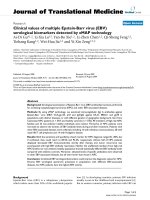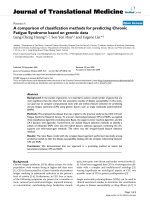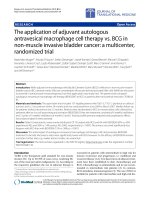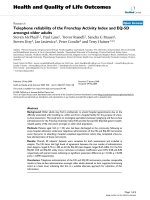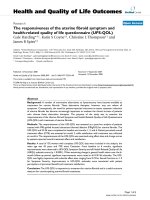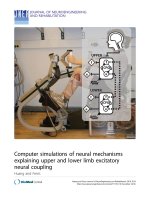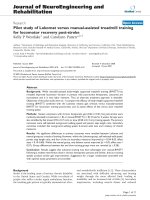Báo cáo hóa học: " Nutraceutical augmentation of circulating endothelial progenitor cells and hematopoietic stem cells in human subjects" potx
Bạn đang xem bản rút gọn của tài liệu. Xem và tải ngay bản đầy đủ của tài liệu tại đây (645.48 KB, 10 trang )
RESEA R C H Open Access
Nutraceutical augmentation of circulating
endothelial progenitor cells and hematopoietic
stem cells in human subjects
Nina A Mikirova
1,11
, James A Jackson
2,11
, Ron Hunninghake
2,11
, Julian Kenyon
3,11
, Kyle WH Chan
4,11
,
Cathy A Swindlehurst
5,11
, Boris Minev
6,11
, Amit N Patel
7,11
, Michael P Murphy
8,11
, Leonard Smith
9,11
,
Famela Ramos
9,11
, Thomas E Ichim
9,11*
, Neil H Riordan
1,9,10,11
Abstract
The medical significance of circulating endothelial or hematopoietic progenitors is becoming increasing recog-
nized. While therapeutic augmentation of circulating progenitor cells using G-CSF has resulted in promising precli-
nical and early clinical data for several degenerative conditions, this approach is limited by cost and inability to
perform chronic administration. Stem-Kine is a food supplement that was previously reported to augment circulat-
ing EPC in a pilot study. Here we report a trial in 18 healthy volunteers administered Stem-Kine twice daily for a
2 week period. Significant increases in circulating CD133 and CD34 cells were observed at days 1, 2, 7, and 14
subsequent to initiation of administration, which correlated with increased hematopoietic progenitors as detected
by the HALO assay. Augmentation of EPC numbers in circulation was detected by KDR-1/CD34 staining and
colony forming assays. These data suggest Stem-Kine supplementation may be useful as a stimulator of reparative
processes associated with mobilization of hematopoietic and endothelial progenitors.
Introduction
Autologous bone marrow derived stem cell therapy has
demonstrated benefit in early clinical trials for condi-
tions such as critical limb ischemia [1,2], post infarct
remodeling [3], stroke [4,5], and liver failure [6]. While
original mechanisms of action were believed to be asso-
ciated with transdifferentiation of progenitor cells to
injured tissues, more recent data supports the notion
that trophic/paracrine mechanisms may be involved. In
this scenario the primary therapeutic function of the
administered cells is production of growth factors/anti-
apoptotic factors that accelerate tissue healing [7-9].
Unfortunately, despite our more advance d mechanistic
underst anding of cellular therapy, its wide spre ad imple-
mentation is hindered by need for complex cell proces-
sing facilities that are only available at limited medical
institutions. A more simplistic strategy would involve
administration of agents capable of enhancing endogen-
ous stem cell activity, or alternatively mobilizing bone
marrow resid ent stem cells to increase concentration to
an area of need.
It is known that subsequent to a variety of tissue inju-
ries, such as myocar dial infar ction [10], stroke [11], and
long bone fractures [12,13], endogenous stem cells are
mobilized to the periphery, en route to the site of
damage. The cyt okines stromal derived factor (SDF-1)
[10], vascular endothelial growth factor (VEGF) [14],
and hepatocyte growth factor (HGF-1) [15] appear to
act as homing signals generated by injured tissues for
reparative cells. Given that stem cell mobilization
appears to be associated with response to injury, one
therapeutic approach has been to artificially augment
mobilization subsequent to tissue damage by administra-
tion of mobilizing agents. In this manner the increased
number of circulating stem cells are more available to
respond to injury signals, hypothetically resulting in
enhanced healing.
Granulocyte colony stimulating factor (G-CSF) and
granulocyte-macrophage colony stimulating factor (GM-
CSF) have been used in hematology for over two dec-
ades to mobilize donor hematopoietic stem cells [16,17].
* Correspondence:
9
Medistem Inc, San Diego, California, USA
Mikirova et al. Journal of Translational Medicine 2010, 8:34
/>© 2010 Mikirova et al; licensee BioMed Central Ltd. This is an Open Access article distri buted under the terms of t he Creative Commons
Attribution License ( which permits unrestricted use, distribution, and reproduction in
any medium, provided the original work is properly cited.
Thesemobilizershaverecentlybeenusedinnon-hema-
tological clinical trials to stimulate post-injury healing
processes. For example, in a trial of post acute myocar-
dial infarct patients, administration of G-CSF for 5 days
resulted in si gnificant inhibition of pathological remo-
deling and improvement in ejection fraction [18]. In the
chronic injury setting, a trial of 45 patients with periph-
eral artery disease demonstrated improvement in vascu-
lar reactivity and walking time 12-weeks after a 2 week
treatment with GM-CSF [19]. Improvements in
endothelial function have also been reported in cancer
patients post G-CSF mobilization [20]. Other studies
have demonstrated the feasibility of stem cell mobiliza-
tion as a possible therapy in diverse degenerative condi-
tions such as liver failure [21,22] and ALS [23].
Chronic stimulation of stem cell mobilization is not
possible using agents such as G-CSF, due to cost and
possible adverse effects such as thrombosis which would
be enhanced after long-term use [24]. Less invasive
interventions have been reported to augment circulating
stem cells such as smoking cessation or exercise [25,26].
In the current study we investigated whether a commer-
cially-available nutraceutical, Stem-Kine (Aidan Pro-
ducts, Chandler AZ), was capable of increasing the
number of circulating stem cells and progenitor cells.
This proprietary food supplement is produced by fer-
mentation of a combination of green tea, astralagus, goji
berry extracts, with food-derived lact obacillus Fermen-
tum together with ellagic acid, beta 1,3 glucan and vita-
min D3. In a previous study we reported preliminary
data on incre ased circulating endothelial progenitor cell
(EPC) levels subsequent to administrati on (Mikirova
et al. Journal of Translational Medicine in press). In the
current study w e sought to assess kinetics of EPC and
stem cell mobilization in a larger population. Augmenta-
tion of both CD133 and CD34 cells in circulation was
observed, as well as KDR-1+/CD34+ EPC capable of
forming endothelial colonie s. In contrast to pre-treat-
ment levels, circulating stem/EPC cells were observed to
undergo an approximate 2-fold increase as a result of
daily supplementation.
Materials and methods
Study population and treatment
The study was conducted under Institution al Review
Board Approval of The Center for Improvement of
Human H ealth Int ernational, Wichita, K ansas, USA,
IRB # 2009-02. Eighteen adults ages 20 -72 where
recruit ed into the study after understanding and signing
informed consent. Exclusion criteria included: systemic
immune-compromised state, ongoing infection or dis-
ease condit ions, and significant abnormalities in bio-
chemistry or complete blood count panels. Subjects
ceased any nut ritional supplementation such as vitamins
and minerals 4-5 days before trial initiation. Two 8 ml
blood draws in heparinized Vacutainer tubes were col-
lected by venipuncture before administration of Stem-
Kine supplementation (day 0) and at days 1, 2, 7, and
14. Study participants were required to ingest two cap-
sules of Stem-Kine in the morning and two in the eve-
ning for 14 days.
Phenotypic assessment of circulating stem cells
Peripheral blood mononuclear cells (PBMC) were iso-
lated by the Ficoll-Hypaque (Fisher Scientific, Ports-
mouth NH) method [27]. Briefly, blood samples were
diluted two-fold with PBS and layered onto Ficoll-
Hypaque in 50-ml conical tubes (Corning, Acton, MA).
Each tube was centrifuged at 400 g for 30 min and the
lymphocytes at the interface were collected. Cells were
washed twice with RPMI 1640 medium containing 100
U/ml penicillin, 100 μg/ml streptomycin, and 2 mM
L-glutamine, and subsequently resuspended in 100 ul
(0.5 M cells per 100 ul) of buffer (PBS+0.5% BSA).
Cells were stained with anti-CD45-FITC (BD Pharmin-
gen), antihuman-KDR-PE, anti-CD34-PE (BD Pharmi-
nogen), CD133/AC133-PE (Miltenyi Biotec), or isotype
controls recommended by manufacturer. Specifically,
10 ul of antibody was added per 100 ul of resuspended
cells and refrigerated in the dark for 15 min (4-8) C.
Cells were washed in 2 ml of PBS with 0.5% BSA and
resuspended in 100 ul of buffer for analysis. Flow cyto-
metry was performed using a Cell Lab Quant SC sys-
tem (Beckman Coulter) equipped with 22 mW argon
laser tuned at 488 nm, with the total number of cells
counted cells being 30,000 per sample. The percentage
of CD133 and CD34 positive cells was calculated based
on the measured number of leukocytes (CD45-positive
cells).
Quantification of EPC based on colony forming ability
EPC cultures were performed using a modification of
the previously described method [28 -31]. Briefly, PBMC
were plated on 24-well fibronectin-coated plates in
Endocult liquid medium, comprised of EndoCult basal
Medium and EndoCult supplement with growth factors
and 2% fetal calf serum (Stem Cell Technologies, Van-
couver, Canada). Cells were plated at a concentration
1 million cells per well for 5 days. For each subject colo-
nies were plated in triplicate. Colonies represented clus-
ters of more than 50 cells circumscribed by spindle
shaped cells and were counted by microscope. As the
number of colonies depends on the number of plated
cells, normalization of colony number based amount of
cells plated was performed twice. The coefficient for
normalization was calculated from the level of ATP for
the same amount of plated cells after 5 days of plating
in medium without growth factors.
Mikirova et al. Journal of Translational Medicine 2010, 8:34
/>Page 2 of 10
HALO hematopoietic progenitor assay
The Hematopoietic/Hemotoxicity Assay via Lumines-
cent
Output (HALO, HemoGenix, Inc) assay was per-
formed according to the manufacturer’s instructions
[32]. Briefly, PBMC were plated in a methylcellulose
media (HemoGenix) with and without the addition of a
growth factor cocktail consisting of erythropoietin (EPO,
3 U/mL), granulocyte-macrophage-colony-stimulating
factor (GM-CSF, 20 ng/mL), granulocyte c olony-stimu-
lating factor (G-CSF, 20 ng/mL), interleukin-3 (IL-3,
10 ng/mL), interleukin-6 (IL-6, 20 ng/mL), stem cell fac-
tor (SCF, 50 ng/mL), thrombopoietin (TPO, 50 ng/mL),
and Flt-3 ligand (10 ng/mL). Cells were plated at a con-
centration of 20000 cells per well in 96 well plates.
After 5 days of culture, level of cellular ATP was quanti-
fied by bio-luminescence. The ratio of average values of
ATP in growth factor stimulated and not stimulated
cells was calculated and compared for d ifferent periods
before and after intervention.
Statistics
Dif ferences between the groups we re assessed using the
non-parametric Wilcoxon rank test and P < 0.05 was
considered to indicate statistical significance.
Results
Stem-Kine mobilizes CD34 and CD133 Cells
Quantification of peripheral blood cells expressing the
hematopoietic stem cell markers CD133 and CD34 was
performed at day 0 (pre-treatment) and on days 1, 2, 7
and 14 subsequent to initiation of Stem-Kine supple-
mentation. The average circulating CD133 cell numbers
from all treated subjects peaked at 90.35% of pretreat-
ment values (p = 0.01) on day 7 (Figure 1), whereas cir-
culating CD34 counts reached a maximal level of
53.13% (p = .04) increase on day 2 (Figure 2). These
data suggest that Stem- Kine administration is associated
with significant mobilization of cells expressing hemato-
poietic stem cell markers. Data is presented as percen-
tage of mononuclear cells in Additional File 1.
Analysis of the number of the progenitor cells in
circulation by HALO assay
Cells expressing the CD34 and CD133 markers are
associated with hematopoietic activity [33,34]. To
assess whether Stem-Kine supplementation altered
levels of functional hematopoietic progenitor cells in
peripheral blood, the HALO assay [32], a modified
form of the classical colony-forming assay, was used
Figure 1 Stem-Kine Supplementation Augments Circulating CD133 Expressing Cells. PBMC from 18 healthy volunteers were assessed by
flow cytometry for expression of CD133 at days 0, 1, 2, 7, and 14 after initiation of twice daily Stem-Kine administration. Data is presented as
percentage over control of average values from all 18 subjects. *P < 0.05 compared to pre-treatment group.
Mikirova et al. Journal of Translational Medicine 2010, 8:34
/>Page 3 of 10
[35,36]. This technique is based on augmentation of
ATP activity (indi cating cellular metabolism) in cul-
tures treated with hematopoietic growth factors versus
control cultures. Increased hematopoietic cell growth
was microscopically observed in treated culture s as
seen in Figure 3. Data presented in Figure 4 represent
the average ATP content in growth factor treated ver-
sus control (mean ± SE) for cells extracted before
Stem-Kine supplementation and days 1, 2, 7, and 14.
The ratio of the average ATP was increased after 24
hrs of supplementation from a pre-treatment level of
2.13 ± 0.0.44 to 2.57 ± 0.47 (p = 0.02). After 48 hrs
and 7 days of supplementation, the ratio was 2.36 ±
0.5 (p = 0.05) and 2.35 ± 0.5 (p = 0 .07). These data
suggest Stem-Kine supplementation increases circula-
tion of cells capable of giving rise to hematopoietic-
lineage cells in vitro.
Stem-Kine augments circulation of cells with
EPC phenotype
Agents such as G-CSF t hat induce HSC mobilization
have been reported to also promote EPC mobilization
[37]. Although similar molecular processes may be
involved, studies suggest unique cytokine cocktails
mobilize distinct stem cell populations [38,39]. Given
that CD34 and CD133 are also markers of EPC [25], we
sought to examine whether Stem-Kine affected EPC
levels in the periphery. EPC phenotypically have been
characterized by co-expression of CD34 and the kinase
insert domain receptor (KDR) [40,41]. Assessment of
cells bearing this phenotype was performed at similar
timepoints to CD34/C133 expression pre- and post-
Stem-Kine administration. Significant increases of circu-
lating cells expressing the EPC phenotype were observed
at days 2 (36.12% compared to pre-treatment control
p = 0.04) and 7 (95.35% compared to pretreatment
control, p = .001) as shown in Figure 5.
Stem-Kine increases circulating cells with EPC activity
Figure 6 illustrates morphology of a typical CFU-E. As
seen in Figure 7, significant (p < 0.05) increases in col-
ony formation were observed blood extracted on days 1
and 2. This was confirmed by visual co lony counting as
well as using the AlphaEase image analysis system.
These data suggest Stem-Kine supplementation aug-
ments circulating levels of cells that not only bear t he
EPC phenotype, but are capable of forming CFU-E
in vitro.
Figure 2 Stem-Kine Supplementa tion Augments Circulating CD34 Expressing Cells. PBMC from 18 healthy volunteer s were asse ssed by
flow cytometry for expression of CD34 at days 0, 1, 2, 7, and 14 after initiation of twice daily Stem-Kine administration. Data is presented as
percentage over control of average values from all 18 subjects. *P < 0.05 compared to pre-treatment group.
Mikirova et al. Journal of Translational Medicine 2010, 8:34
/>Page 4 of 10
Figure 3 Stim ulation of Hematopoietic Progeny from PBMC (HALO Assay): PBMC were plated at a concentration of 20,00 0 cells per well
and cultured on a methylcellulose matrix for 5 days supplemented with; (a) control media or (b) an optimized hematopoietic growth factor
cocktail as described in Materials and Methods.
Figure 4 Stem-Kine Supplementation In creases Hematopoietic Progenitor Cells in Circulation. PBMC from subjects supplement with
Stem-Kine were extracted at the indicated timepoints and cultured for 5 days in the presence of control media or hematopoietic cytokines.
Ratio of ATP between activated and control cells is illustrated on the y-axis. *P < 0.05 compared to pre-treatment groups.
Mikirova et al. Journal of Translational Medicine 2010, 8:34
/>Page 5 of 10
Figure 5 Augmentation of KDR/CD34 posit ive cell numbers in circulation after Stem-Kine a dministration. PBMC from 18 healthy
volunteers were assessed by flow cytometry for coexpression of CD34 and KDR at days 0, 1, 2, 7, and 14 after initiation of twice daily Stem-Kine
administration. *P < 0.05 compared to pre-treatment groups.
Figure 6 Colony Forming Unit Endothelium Assay: PBMC were plated on 24-well fibronectin-coated plates at a concentration of 10 (6) cells
per well. After 5 days of culture cells were Giemsa stained and clusters of > 50 cells were quantified as colonies.
Mikirova et al. Journal of Translational Medicine 2010, 8:34
/>Page 6 of 10
Discussion
Hematopoietic stem cells at various stages of differentia-
tion are localized in the bone-marrow. At a basal rate
low levels of stem/progenitor cells are released from
their niche and circulate in the peripheral blood [42].
Initially, upregulation of peripheral blood hematopoietic
stem cell numbers was believed to be limited to post-
bone marrow injury conditions [43], subsequent studies
have expanded this finding to situations of inflammation
[44], and peripheral tissue injury [45-47]. Hematopoietic
stem cells are being increasingly recognized as having
diverse non-hematopoietic functions including produc-
tion of angiogenic cytokines [48], and acting as an
“innate” immune cell capable of rapidly differentiating
into dendritic cells for protection of the host against
infections [49]. Circulating EPC are derived from the
same lineage as hematopoietic cells [50], and are
believed to play a role in replenishing the vasculature
[51-53]. Numerous conditions including Alzheimer’ s
Disease [54], migraine headaches [55], erectile dysfunc-
tion [56], diabetes, and peripheral vascular disease are
associated with decrease s in circulating EPC, possibly as
a result of chronic inflammatory mediators associated
with these conditions [57,58]. In contrast, acute injury
such as myocardial infarction [59,60] and stroke [61],
are associated with upregulated levels of these cells.
Given the possibility that both hematopoietic stem cells
and EPC may serve as endogenous “repair cells” ,we
sought to assess a relatively non-invasive means of mod-
ulating these cells.
Stem-Kine is a commercially available food supple-
ment whose intake has been associated with a variety of
anecdotal reports o f health improvement such as
increased energy levels, enhanced skin quality, resistance
to infection, and accelerated post-infection recovery. We
found that administration of Stem-Kine over a 2-week
course wa s well tol erated with no adverse effects
reported. Supplementation was associated with a peak
increase of approximately 53% in the number of CD34
expressing cells and and a 90% increase in CD133 cells
in circulation. Furthermore, a significant augmentation
of cell s possessing hematopoietic colony forming activity
was found in PBMC by the HALO assay. The levels of
mobilization associated with Stem-Kine administration
are closer to conditions that can be maintained over
long term use, which is not possible with current ly
Figure 7 Stem-Kine Supplementation Augments Circulating Cells with CFU-E Generating Activity. CFU-E were generated by incubation of
PBMC isolated from healthy volunteers with EndoCult Media. Data is presented as ratio to pre-treatment values. Open squares represent
quantification by Alpha-Ease software, whereas closed symbols indicate quantification per viewing field by microscope. *P < 0.05 compared to
pre-treatment groups.
Mikirova et al. Journal of Translational Medicine 2010, 8:34
/>Page 7 of 10
available mobilizers. For example, G-CSF administration
at a conventionally used dose, 12 micrograms/kg for
6 days, results in a 58-fold increase in granulocytic pro-
genitors and 24-fold increase in erythroid progenitors
[62], which approximately correlated with CD34 counts
[63]. Maintaining such extreme levels of mobilization
over a long term increases the risk of extramedullary
hematopoiesis [64], bone marrow depletion [65], a nd
thrombosis as a result of chronic leukocytosis [24].
Indeed current indications for G-CSF recommend its
use be limited to no more than 7 days for purposes of
mobilization [66]. The recently approved drug AMD-
3100 stimulat es CD 34 and CFU-GM mobilization
approximately h alf of values obtained for G-CSF alone,
however has been demonstrated to synergize with
G-C SF [67]. The rapid onset and extent of mobilization
limits chronic administration. As w ith other mobilizing
agents, Stem-Kine peripheralization of CD34 and CD133
cells started to drop on day 14 of administration. This
maybeaphysiologicalresponsetowardsmaintaininga
constant level of circulating progenitor cells. Indeed it
maybepossiblethatStem-Kinecouldbebeneficialin
conditions associated with reduced progenitor cells such
as diabetes or in smokers which possess lower b aseline
values as compared to controls [25,26,57,58].
While we correlated an increase in hema topoietic
colonies with Stem-Kine induced upregulation of pe r-
ipheral blood CD34 and CD133 ce lls, given t hat these
markers are also found on EPC [25], we evaluated the
possibility that circulating EPC numbers were also
increased . We observed maximal increases (almost dou-
bling) of CD34+ KDR+ cells in PBMC occurring at day
7 of supplementation, whereas peak CFU-E activity
occurred at day 2. The reason for this discrepancy is not
known, but potentially may be related to existence of
various subsets of cells with EPC potentia l residing out-
side of the CD34+ KDR+ fraction. Further studies are
required to elucidate functional importance of the vari-
able kinetics of mobilization,aswellaspossiblediffer-
ences on long-term versus short-term circulating EPC.
The mechanism of Stem-Kine mediated mobilization
remains unknown. One possibility is that a temporary
disruption of the SDF-1a/CXCR4 axis is occurring, in a
similar manner to mobilization induced by G-CSF or
cyclophosphamide [68]. Not mutually exclusive is the
possibility that Stem-Kine is activating bone marrow
resident macrophages, elaborating cytokines associated
with mobilization [69]. We are favoring this possibility
based on agents that induce mobilization in the relative
potency range associated with Stem-Kine. For example,
specific molecular weight ranges of hyaluronic acid
have been demonstrated to induce mild mobilization
[70,71], an effect that is associated with bone marrow
macrophage production of IL-1 and IL-6 [72]. Peptido-
glycan components which are found in Stem-Kine are
known to activate macrophages and stimulate produc-
tion of IL-6 [73].
To our knowledge, this is the first study demonstrat-
ing profound mobilization effect with possible clinical
significance by a food supplement-based approach. The
nutritional supplement StemEnhance, is an extract of
the cyanobacteria Aphanizomenon flos-aquae [74].
Jensen et al which demonstrated a 25% increase in cir-
culating CD34+ cells, which peaked at 60 minutes-post
administration and subsided at 120 minutes [75].
Another nutraceutical product, Nutra-Stem, is com-
posed of a combination of blueberries, green tea extract,
carnosine, and vitamin D3. In vi tro activity on prolifera-
tion of human bone marrow cells was assessed, in which
a 60% enhancement of growth was reported [76]. Bone
marrow cells from mice supplemented with Nutra-Stem
were protected from in vitro exposure to hydrogen per-
oxide a t up to approximately 40% [77]. These data sug-
gest the possibility of nutritional modulation of stem
cell compartments, but do not provide results on mobi-
lization. Further research is required to assess physiolo-
gical effects in humans.
In conclusion, the curren t study suggests feasibility of
significant mobilization of cells expressing hematopoietic
stem cell and EPC markers and properties. The area of
nutritional modulation of the stem cell compartment
offers significant benefit in treatment of a wide variety
of degenerative diseases. However given commercial
pressures associated with this largely unregulated field,
we propose detailed scientific investigations must be
made before disease-associated claims are made by the
scientific community.
Additional file 1: Progenitor Cell Numbers Expressed as a
Percentage of Peripheral Blood Mononuclear Cells. The data
provided represent number of progenitor cells (CD133, CD34, and cells
with EPC functional activity) as a percentage of peripheral blood
mononuclear cells.
Acknowledgements
This study was supported in part by Allan P Markin, The Aidan Foundation,
and the Center For The Improvement Of Human Functioning International.
Author details
1
Bio-Communications Research Institute, Wichita, Kansas, USA.
2
The Center
For The Improvement Of Human Functioning International, Wichita, Kansas,
USA.
3
The Dove Clinic for Integrated Medicine, Hampshire, UK.
4
Biotheryx
Inc, San Diego, California, USA.
5
Novomedix, San Diego, California, USA.
6
Moores Cancer Center, University of California San Diego and Division of
Neurosurgery, University of California San Diego, California, USA.
7
Department of Cardiothoracic Surgery, University of Utah, Salt Lake City, UT,
USA.
8
Division of Medicine, Indiana University School of Medicine, IN, USA.
9
Medistem Inc, San Diego, California, USA.
10
Georgetown Dermatology,
Washington, DC, USA.
11
Aidan Products, Chandler, Arizona, USA.
Mikirova et al. Journal of Translational Medicine 2010, 8:34
/>Page 8 of 10
Authors’ contributions
NHR and NAM designed experiments, interpreted data and conceptualized
manuscript. RH, JAK, JK, KWA, CAS, BM, ANP, MPM, LS, FR, and TEI provided
detailed ideas and discussions, and/or writing of the manuscript. NAM and
JAJ performed the experiments. All authors read and approved the final
manuscript.
Competing interests
Neil H Riordan is a shareholder of Aidan Products. All other authors have no
competing interests.
Received: 5 February 2010 Accepted: 8 April 2010
Published: 8 April 2010
References
1. Kawamoto A, Katayama M, Handa N, et al: Intramuscular transplantation
of G-CSF-mobilized CD34(+) cells in patients with critical limb ischemia:
a phase I/IIa, multicenter, single-blinded, dose-escalation clinical trial.
Stem Cells 2009, 27(11):2857-64.
2. Keller LH: Bone marrow-derived aldehyde dehydrogenase-bright stem
and progenitor cells for ischemic repair. Congest Heart Fail 2009,
15(4):202-6.
3. Singh S, Arora R, Handa K, Khraisat A, Nagajothi N, Molnar J, Khosla S: Stem
cells improve left ventricular function in acute myocardial infarction. Clin
Cardiol 2009, 32(4):176-80.
4. Fischer-Rasokat U, Assmus B, Seeger FH, et al: A pilot trial to assess
potential effects of selective intracoronary bone marrow-derived
progenitor cell infusion in patients with nonischemic dilated
cardiomyopathy: final 1-year results of the transplantation of progenitor
cells and functional regeneration enhancement pilot trial in patients
with nonischemic dilated cardiomyopathy. Circ Heart Fail 2009,
2(5):417-23.
5. Suarez-Monteagudo C, Hernandez-Ramirez P, Alvarez-Gonzalez L, et al:
Autologous bone marrow stem cell neurotransplantation in stroke
patients. An open study. Restor Neurol Neurosci 2009, 27(3):151-61.
6. Pai M, Zacharoulis D, Milicevic MN, et al: Autologous infusion of expanded
mobilized adult bone marrow-derived CD34+ cells into patients with
alcoholic liver cirrhosis. Am J Gastroenterol 2008, 103(8):1952-8.
7. Caplan AI, Dennis JE: Mesenchymal stem cells as trophic mediators. J Cell
Biochem 2006, 98(5):1076-84.
8. Ventura C, Cavallini C, Bianchi F, Cantoni S: Stem cells and cardiovascular
repair: a role for natural and synthetic molecules harboring
differentiating and paracrine logics. Cardiovasc Hematol Agents Med Chem
2008, 6(1):60-8.
9. Shabbir A, Zisa D, Suzuki G, Lee T: Heart failure therapy mediated by the
trophic activities of bone marrow mesenchymal stem cells:
a noninvasive therapeutic regimen. Am J Physiol Heart Circ Physiol 2009,
296(6):H1888-97.
10. Brehm M, Ebner P, Picard F, Urbien R, Turan G, Strauer BE: Enhanced
mobilization of CD34(+) progenitor cells expressing cell adhesion
molecules in patients with STEMI. Clin Res Cardiol 2009, 98(8):477-86.
11. Dunac A, Frelin C, Popolo-Blondeau M, Chatel M, Mahagne MH, Philip PJ:
Neurological and functional recovery in human stroke are associated
with peripheral blood CD34+ cell mobilization. J Neurol 2007,
254(3):327-32.
12. Lee DY, Cho TJ, Kim JA, Lee HR, Yoo WJ, Chung CY, Choi IH: Mobilization
of endothelial progenitor cells in fracture healing and distraction
osteogenesis. Bone 2008, 42(5):932-41.
13. Matsumoto T, Mifune Y, Kawamoto A, et al: Fracture induced mobilization
and incorporation of bone marrow-derived endothelial progenitor cells
for bone healing. J Cell Physiol 2008, 215(1)
:234-42.
14. Das R, Jahr H, van Osch G, Farrell E: The role of hypoxia in MSCs:
Considerations for regenerative medicine approaches. Tissue Eng Part B
Rev 2009, 42(5):234-42.
15. Vandervelde S, van Luyn MJ, Tio RA, Harmsen MC: Signaling factors in
stem cell-mediated repair of infarcted myocardium. J Mol Cell Cardiol
2005, 39(2):363-76.
16. Mohle R, Kanz L: Hematopoietic growth factors for hematopoietic stem
cell mobilization and expansion. Semin Hematol 2007, 44(3):193-202.
17. Gianni AM, Siena S, Bregni M, Tarella C, Stern AC, Pileri A, Bonadonna G:
Granulocyte-macrophage colony-stimulating factor to harvest circulating
haemopoietic stem cells for autotransplantation. Lancet 1989,
2(8663):580-5.
18. Leone AM, Galiuto L, Garramone B, et al: Usefulness of granulocyte
colony-stimulating factor in patients with a large anterior wall acute
myocardial infarction to prevent left ventricular remodeling (the
rigenera study). Am J Cardiol 2007, 100(3):397-403.
19. Subramaniyam V, Waller EK, Murrow JR, et al: Bone marrow mobilization
with granulocyte macrophage colony-stimulating factor improves
endothelial dysfunction and exercise capacity in patients with peripheral
arterial disease. Am Heart J 2009, 158(1):53-60, e1.
20. Ikonomidis I, Papadimitriou C, Vamvakou G, et al: Treatment with
granulocyte colony stimulating factor is associated with improvement in
endothelial function. Growth Factors 2008, 26(3):117-24.
21. Spahr L, Lambert JF, Rubbia-Brandt L, Chalandon Y, Frossard JL, Giostra E,
Hadengue A: Granulocyte-colony stimulating factor induces proliferation
of hepatic progenitors in alcoholic steatohepatitis: a randomized trial.
Hepatology 2008, 48(1):221-9.
22. Di Campli C, Zocco MA, Saulnier N, et al: Safety and efficacy profile of G-
CSF therapy in patients with acute on chronic liver failure. Dig Liver Dis
2007, 39(12):1071-6.
23. Cashman N, Tan LY, Krieger C, et al: Pilot study of granulocyte colony
stimulating factor (G-CSF)-mobilized peripheral blood stem cells in
amyotrophic lateral sclerosis (ALS). Muscle Nerve 2008, 37(5):620-5.
24. Nadir Y, Hoffman R, Brenner B: Drug-related thrombosis in hematologic
malignancies. Rev Clin Exp Hematol 2004, 8(1):E4.
25. Kondo T, Hayashi M, Takeshita K, Numaguchi Y, Kobayashi K, Iino S, Inden Y,
Murohara T: Smoking cessation rapidly increases circulating progenitor
cells in peripheral blood in chronic smokers. Arterioscler Thromb Vasc Biol
2004, 24(8):1442-7.
26. Mobius-Winkler S, Hilberg T, Menzel K, Golla E, Burman A, Schuler G,
Adams V:
Time-dependent mobilization of circulating progenitor cells
during strenuous exercise in healthy individuals. J Appl Physiol 2009,
107(6):1943-50.
27. Kmieciak M, Gowda M, Graham L, Godder K, Bear HD, Marincola FM,
Manjili MH: Human T cells express CD25 and Foxp3 upon activation and
exhibit effector/memory phenotypes without any regulatory/suppressor
function. J Transl Med 2009, 7:89.
28. Hill JMZG, Halcox JP, Schenke WH, Wacliwiw MA, Quyyumi AA, Finkel T:
Circulating endothelial progenitor cells, vascular function and
cardiovascular risk. M Engl J Med 2003, 348:593-600.
29. Vasa MFS, Aicher A, Adler K, Urbich C, martin H, Zeiher AM, Dimmeler S:
Number and migratory activity of circulating endothelial cells inversely
correlate with risk factors for coronary heart disease. Circ Res 2001, 89:
e1-e7.
30. Werner NK, Osiol S, Schiegl T, Ahlers P, Walenta K, Link A, Bohm M,
Nickenig G: Circulating endothelial progenitor cells and cardio-vascular
outcomes. N Engl J Med 1007, 353:999-2005.
31. Rehman JLJ, Parvathaneni L, Karlsson G, Panchal VR, Temm CJ,
Mahenthiran J, March KL: Exercise acutely increases circulating
endothelial progenitor cells and monocyte-/macrophage-derived
angiogenic cells. J Am Coll Cardiol 2004, 43:2314-2318.
32. Rich IN: In vitro hematotoxicity testing in drug development: a review of
past, present and future applications. Curr Opin Drug Discov Devel 2003,
6(1):100-9.
33. Charrier S, Boiret N, Fouassier M, et al: Normal human bone marrow CD34
(+)CD133(+) cells contain primitive cells able to produce different
categories of colony-forming unit megakaryocytes in vitro. Exp Hematol
2002, 30(9):1051-60.
34. Handgretinger R, Gordon PR, Leimig T, Chen X, Buhring HJ, Niethammer D,
Kuci S: Biology and plasticity of CD133+ hematopoietic stem cells. Ann N
Y Acad Sci 2003, 996:141-51.
35. Rich IN: HKVadoappfhuambc-fpaTS. 2005, 87:427-441.
36. Crouch SPMKR, Slater KJ, Fletcher J: The use of ATP bioluminescence as a
measure of cell proliferation and cytotoxicity. L immunol meth 2000,
160:81-88.
37. Mauro E, Rigolin GM, Fraulini C, Sofritti O, Ciccone M, De Angeli C,
Castoldi G, Cuneo A: Mobilization of endothelial progenitor cells in
patients with hematological malignancies after treatment with filgrastim
and chemotherapy for autologous transplantation. Eur J Haematol 2007,
78(5):374-80.
Mikirova et al. Journal of Translational Medicine 2010, 8:34
/>Page 9 of 10
38. Kolonin MG, Simmons PJ: Combinatorial stem cell mobilization. Nat
Biotechnol 2009, 27(3):252-3.
39. Pitchford SC, Furze RC, Jones CP, Wengner AM, Rankin SM: Differential
mobilization of subsets of progenitor cells from the bone marrow. Cell
Stem Cell 2009, 4(1):62-72.
40. Westerweel PE, Visseren FL, Hajer GR, et al: Endothelial progenitor cell
levels in obese men with the metabolic syndrome and the effect of
simvastatin monotherapy vs. simvastatin/ezetimibe combination
therapy. Eur Heart J 2008, 29(22):2808-17.
41. Jie KE, Goossens MH, van Oostrom O, Lilien MR, Verhaar MC: Circulating
endothelial progenitor cell levels are higher during childhood than in
adult life. Atherosclerosis 2009, 202(2):345-7.
42. Barnes DW, Loutit JF: Haemopoietic stem cells in the peripheral blood.
Lancet 1967, 2(7526):1138-41.
43. Fried W, Johnson C: The effect of cyclophosphamide on hematopoietic
stem cells. Radiat Res 1968, 36(3):521-7.
44. Vos O, Buurman WA, Ploemacher RE: Mobilization of haemopoietic stem
cells (CFU) into the peripheral blood of the mouse; effects of endotoxin
and other compounds. Cell Tissue Kinet 1972, 5(6):467-79.
45. Taguchi A, Nakagomi N, Matsuyama T, et al: Circulating CD34-positive cells
have prognostic value for neurologic function in patients with past
cerebral infarction. J Cereb Blood Flow Metab 2009, 29(1):34-8.
46. Turan RG, Brehm M, Koestering M, et al: Factors influencing spontaneous
mobilization of CD34+ and CD133+ progenitor cells after myocardial
infarction. Eur J Clin Invest 2007, 37(11):842-51.
47. Kissel CK, Lehmann R, Assmus B, et al: Selective functional exhaustion of
hematopoietic progenitor cells in the bone marrow of patients with
postinfarction heart failure. J Am Coll Cardiol 2007, 49(24):2341-9.
48. Strate van der BW, Popa ER, Schipper M, Brouwer LA, Hendriks M,
Harmsen MC, van Luyn MJ: Circulating human CD34+ progenitor cells
modulate neovascularization and inflammation in a nude mouse model.
J Mol Cell Cardiol 2007, 42(6):1086-97.
49. Massberg S, Schaerli P, Knezevic-Maramica I, et al: Immunosurveillance by
hematopoietic progenitor cells trafficking through blood, lymph, and
peripheral tissues. Cell 2007, 131(5):994-1008.
50. Basak GW, Yasukawa S, Alfaro A, Halligan S, Srivastava AS, Min WP, Minev B,
Carrier E: Human embryonic stem cells hemangioblast express
HLA-antigens. J Transl Med 2009, 7:27.
51. Foteinos G, Hu Y, Xiao Q, Metzler B, Xu Q: Rapid endothelial turnover in
atherosclerosis-prone areas coincides with stem cell repair in
apolipoprotein E-deficient mice. Circulation 2008, 117(14):1856-63.
52. Werner N, Junk S, Laufs U, Link A, Walenta K, Bohm M, Nickenig G:
Intravenous transfusion of endothelial progenitor cells reduces
neointima formation after vascular injury. Circ Res 2003, 93(2):e17-24.
53. Wassmann S, Werner N, Czech T, Nickenig G: Improvement of endothelial
function by systemic transfusion of vascular progenitor cells. Circ Res
2006, 99(8):e74-83.
54. Lee ST, Chu K, Jung KH, et al: Reduced circulating angiogenic cells in
Alzheimer disease. Neurology 2009, 72(21):1858-63.
55. Lee ST, Chu K, Jung KH, et al: Decreased number and function of
endothelial progenitor cells in patients with migraine. Neurology 2008,
70(17):1510-7.
56. Esposito K, Ciotola M, Maiorino MI, et al: Circulating CD34+ KDR+
endothelial progenitor cells correlate with erectile function and
endothelial function in overweight men. J Sex Med 2009, 6(1):107-14.
57. Rodriguez-Ayala E, Yao Q, Holmen C, Lindholm B, Sumitran-Holgersson S,
Stenvinkel P: Imbalance between detached circulating endothelial cells
and endothelial progenitor cells in chronic kidney disease. Blood Purif
2006, 24(2):196-202.
58. Verma S, Kuliszewski MA, Li SH, et al: C-reactive protein attenuates
endothelial progenitor cell survival, differentiation, and function: further
evidence of a mechanistic link between C-reactive protein and
cardiovascular disease. Circulation 2004, 109(17):2058-67.
59. Xin Z, Meng W, Ya-Ping H, Wei Z: Different biological properties of
circulating and bone marrow endothelial progenitor cells in acute
myocardial infarction rats. Thorac Cardiovasc Surg 2008, 56(8):441-8.
60. Wojakowski W, Tendera M: Mobilization of bone marrow-derived
progenitor cells in acute coronary syndromes. Folia Histochem Cytobiol
2005, 43(4):229-32.
61. Sobrino T, Hurtado O, Moro MA, et al: The increase of circulating
endothelial progenitor cells after acute ischemic stroke is associated
with good outcome. Stroke 2007, 38(10):2759-64.
62. Sheridan WP, Begley CG, Juttner CA, et al: Effect of peripheral-blood
progenitor cells mobilised by filgrastim (G-CSF) on platelet recovery
after high-dose chemotherapy. Lancet 1992,
339(8794):640-4.
63. Matsunaga T, Sakamaki S, Kohgo Y, Ohi S, Hirayama Y, Niitsu Y:
Recombinant human granulocyte colony-stimulating factor can mobilize
sufficient amounts of peripheral blood stem cells in healthy volunteers
for allogeneic transplantation. Bone Marrow Transplant 1993, 11(2):103-8.
64. Dagdas S, Ozet G, Alanoglu G, Ayli M, Gokmen Akoz A, Erekul S: Unusual
extramedullary hematopoiesis in a patient receiving granulocyte colony-
stimulating factor. Acta Haematol 2006, 116(3):198-202.
65. Majolino I, Cavallaro AM, Scime R: Peripheral blood stem cells for
allogeneic transplantation. Bone Marrow Transplant 1996, 18(Suppl
2):171-4.
66. Neupogen (Filgrastim). [ />67. Broxmeyer HE, Orschell CM, Clapp DW, et al: Rapid mobilization of murine
and human hematopoietic stem and progenitor cells with AMD a
CXCR4 antagonist. J Exp Med 3100, 201(8):1307-18.
68. Levesque JPHJ, Takamatsu Y, Simmons PJ, Bendall LJ: Disruption of the
CXCR4/CXCL12 chemotactic interaction during hematopoietic stem cell
mobilization induced by G-CSF or cyclophosphamide. J Clin Inves 2003,
111:187-196.
69. Cavaillon JMH-CN: Signals involved in interleukin 1 synthesis and release
by lipopolysacchride-stimulated monocyte/macrophages. Cytokines 1990,
2:313.
70. Minguell JJ: Is hyaluronic acid the “organizer” of the extracellular matrix
in marrow stroma? Exp Hematol 1993, 21(1):7-8.
71. Matrosova VY, Orlovskaya IA, Serobyan N, Khaldoyanidi SK: Hyaluronic acid
facilitates the recovery of hematopoiesis following 5-fluorouracil
administration. Stem Cells 2004, 22(4):544-55.
72. Hiro D, Ito A, Matsuta K, Mori Y: Hyaluronic acid is an endogenous
inducer of interleukin-1 production by human monocytes and rabbit
macrophages. Biochem Biophys Res Commun 1986, 140(2):715-22.
73. Riordan , et al: US patent # 6.940.
74. StemTech International Inc. [].
75. Jensen GS, Hart AN, Zaske LA, Drapeau C, Gupta N, Schaeffer DJ,
Cruickshank JA: Mobilization of human CD34+ CD133+ and CD34+
CD133(-) stem cells in vivo by consumption of an extract from
Aphanizomenon flos-aquae–related to modulation of CXCR4 expression
by an L-selectin ligand? Cardiovasc Revasc Med 2007, 8(3):189-202.
76. Bickford PC, Tan J, Shytle RD, Sanberg CD, El-Badri N, Sanberg PR:
Nutraceuticals synergistically promote proliferation of human stem cells.
Stem Cells Dev 2006, 15(1):118-23.
77. Shytle RD, Ehrhart J, Tan J, Vila J, Cole M, Sanberg CD, Sanberg PR,
Bickford PC: Oxidative stress of neural, hematopoietic, and stem cells:
protection by natural compounds. Rejuvenation Res 2007, 10(2):173-8.
doi:10.1186/1479-5876-8-34
Cite this article as: Mikirova et al.: Nutraceutical augmentation of
circulating endothelial progenitor cells and hematopoietic stem cells in
human subjects. Journal of Translational Medicine 2010 8:34.
Submit your next manuscript to BioMed Central
and take full advantage of:
• Convenient online submission
• Thorough peer review
• No space constraints or color figure charges
• Immediate publication on acceptance
• Inclusion in PubMed, CAS, Scopus and Google Scholar
• Research which is freely available for redistribution
Submit your manuscript at
www.biomedcentral.com/submit
Mikirova et al. Journal of Translational Medicine 2010, 8:34
/>Page 10 of 10

